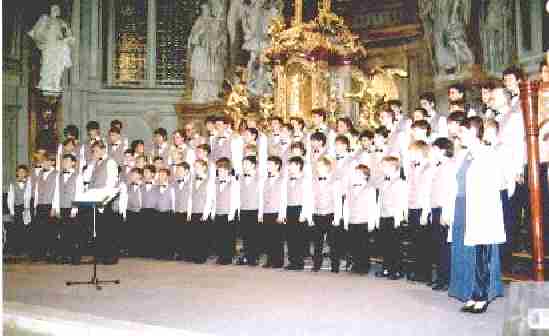
Figure 1.--The Pueri Gaudentes choir wears bow ties, grey vests, and black pants. Like most Eastern European choirs it is of recent origins.


Figure 1.--The Pueri Gaudentes choir wears bow ties, grey vests, and black pants. Like most Eastern European choirs it is of recent origins. |
The Czech Republic is predominately Roman Catholic with a minority Orthadox population. HBC has no infornation on the historical boy choir tradition. HBC knows of one Prague choir of very recent foundation.
The Czech language belongs to the western group of the Slovonic branch of Indo-European languages. It is related to Russian, Polish, and Bulagarian. It was one of the twp official languages of Czecheslovakia and became the langauge of the Czech Repunlic when Slovakia decided to form an independent country. The earliest written forms of the Czech language emplyed Slavic characters, but have been superseeded by Latin characters. Diacritical marks have been added for those native sounds for which the Latin characters were inadequate. The Czech people are predominately Roman Catholic. About 20 percent of the population of the former Czecheslovalia are Orthadox Christians, probably a larger proportion in Slovakia than the Czech Republic. HBC has no information on the historical boy choir tradition. The one known choir is of very recent origins.
HBC knows of only a few Czech boy choirs. Unfortunately very limited infornmation is available about these choirs. Few have web sites. It seems as if most of the Czech choirs have similar costumes. In addition, most of the choirs have chosen Latin names.
The third is called Boni Fantes. The boys wear a white shirt, a dark tie, a
wine-red pullover without sleeves and black long trousers. The young men wear a
black suit instead.
A HBC reader has mentioned the Boni Pueri choir. The boys wear a white shirt, a red jacket and tie. In German it is called Fliege, but you can't translate it as fly,
which is a homonym.
This choir was founded in the 1940s. This seems a strange year to found a choir, coming after the NAZI dimemberment of Czecheslovakia and during World War II. Unfortunately we do not have any historical information about the choir. It is associated with the Prague Philarmonic. It is composed of 12-17 year olds, but I have no information on their costumes.
A hBC reader has also mentioned Pani kluci. (Pani means woman. HBC is not sure why the choir has this name.) The boys and young men wear a white shirt, a greyish violet vest, and black long trousers. It is from Litomerice (Leitmeritz) in Bohemia.
The Pilsen Childrenīs choir has visited about 20 countries, mostly in Europe. The children are from 14-19 yrs old.
Pueri gaudentes in Prague is a separate division of the children's choir Radost - Praha which works at the music school in Prague 7 and associates now more than 500 children
and adult singers in 9 divisions. The name of the choir Pueri gaudentes is derived from the name of the basic choir Radost ("Radost" means English "Joy"). Its members sing with joy and joy is what they want to bring with their songs to their audience. The choir has three departments. There sing now about 45 boys in the age from 11 to 17 and about 30 young men from 15 to 19 in the concert department, while about 60 boys 7-12 years old sing in two preparatory departments. In compliance with well established traditions, boys even after their voices breal remain with the choir. Although they can't appear in the concerts and their singing ability is for some time considerably limited. During this critical period it is felt very important for the boys not to lose contact with the choir, to remain in the cultural milieu of the choir, to attend the rehearals in order to listen, study and increase their professional knowledge. After getting over their voice changing difficulties they become a useful support of the choir's men part. Almost all young men in the choir went through its boys part. Six years of hard work on musical and singing education of the boys has brought fruits. During this period the choir has attained high artistic level which it has confirmed on many concerts in Czech Republic as well as during the tours in Italy, Austria, France, Germany, Belgium and theNetherlands. The boys during their tours not only show their singing artistry, but also deepen the friendly and cultural bonds with their hosts and see as much as possible from the natural beauties, monuments and culture of the host country. During the tours young boys are divided into small groups by two or three. Each group is guided by an adult member. The choir has taken part in international music festivals and competitions for children's choirs in Nantes (1995), Neerpelt (1996) and Lecco (1997) which testifies that the boys are ambitious and want to win recognition even far from their home stages. Regular participation of the choir in State Opera Prague can be considered an appreciation of their qualities: They sing in performances of Bizet's Carmen, Puccini's Turandot and Musorgski's Boris Godunov. In summer 1997 they joined other performers in Bernstein's Mass. The choir is often recorded and filmed for Czech Radio and Television, and records its own CDs.
Navigate the Boys' Historical Clothing Web Site:
[Introduction]
[Activities]
[Biographies]
[Chronology]
[Clothing styles]
[Countries]
[Bibliographies]
[Contributions]
[FAQs]
[Glossaries]
[Satellite sites]
[Tools]
[Boys' Clothing Home]
Navigate the Historic Boys' Clothing Web choir costume pages:
[Return to the Main choir page]
[Return to the Main national choir page]
[Australia]
[Austria]
[Belgium]
[Bulgaria]
[Canada]
[]
[Denmark]
[England]
[France]
[Finland]
[Germany]
[Japan]
[Netherlands]
[Poland]
[South Africa]
[United States]
Navigate the Historic Boys' Clothing Web style pages:
[Short pants suits]
[Blazers]
[Collars]
[Lace collars]
[Ruffled collars]
[Eton collar]
[Fauntleroy suits]
[Sailor suits]
[Ring bearer/page costumes]
[First Communion suits]
